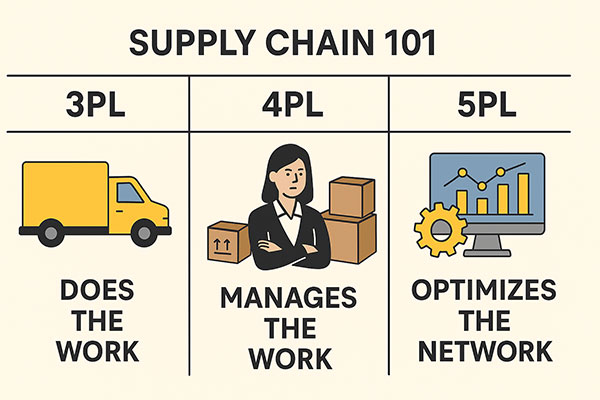If you’ve ever felt confused by the terms 3PL, 4PL, and 5PL, you’re not alone. These labels get tossed around a lot, but many people, even those working in supply chain, don’t fully understand what separates one from the other. Here’s a simple breakdown of what each one means and how they’re used in the real world.
What Is a 3PL?
What’s Related
A Third-Party Logistics provider (3PL) is a company that helps other businesses move, store, and deliver their products.
Real-life example: FitFlop, a global footwear brand, partners with a third-party logistics provider to expand its presence in the U.S. FitFlop still controls what gets shipped and when — the 3PL handles warehousing, fulfillment, and delivery so the brand can focus on growth and customer experience.
What Is a 4PL?
A Fourth-Party Logistics provider (4PL) goes beyond operations — they manage the whole supply chain on your behalf.
A 4PL acts as your single point of contact, overseeing multiple 3PLs, tech providers, and carriers.
They often offer supply chain design, vendor management, and data integration.
Real-life example: Ecopetrol, Colombia’s largest energy company, partnered with GEODIS to manage its entire logistics supply chain. Acting as a 4PL provider, GEODIS coordinated multiple 3PLs and implemented a smart platform to provide real-time, end-to-end visibility. This collaboration streamlined Ecopetrol’s operations, ensuring efficiency and alignment across its complex logistics network.
What Is a 5PL?
A Fifth-Party Logistics provider (5PL) focuses on network-wide optimization, often driven by data, automation, and AI.
They don’t just manage logistics — they design and optimize entire logistics ecosystems.
5PLs are more common in e-commerce and global trade environments.
Real-life example: An e-commerce platform selling across Asia and Europe partners with a 5PL like Flexport, which uses tech to plan and optimize all transportation moves, customs processes, and delivery networks.
When Does a Company Need 3PL, 4PL, or 5PL?
If you’re fulfilling online orders and need basic help, a 3PL is the right fit.
If you’re growing and need help managing multiple logistics partners, consider a 4PL.
If you’re scaling across countries and need deep tech integration and strategy, a 5PL might be the best option.
What’s Next: Future Trends in Logistics Providers
As e-commerce grows and technology keeps moving fast, the line between 3PL, 4PL, and 5PL is starting to blur. Here are a few trends shaping where things are headed:
Tech is moving upstream. More 3PLs are adding advanced tech, like real-time tracking, AI-driven forecasting, and control tower dashboards, once only offered by 4PLs or 5PLs.
4PLs are becoming digital integrators. Companies are using 4PLs to unify messy tech stacks, connect systems, and pull clean data across multiple vendors.
5PLs will drive e-commerce logistics. As global e-commerce gets more complex, expect 5PLs to play a bigger role in building tech-first networks that support fast, affordable, cross-border delivery.
Sustainability will factor into provider selection. Shippers are starting to look beyond price and speed and ask providers how they’re cutting carbon, consolidating loads, and optimizing routes for greener operations.
The demand for flexibility will keep rising: Whether it’s warehousing on demand or switching
Bottom Line
3PLs do the work. 4PLs manage the work. 5PLs optimize the whole network. Each has a role to play — it just depends on how complex your logistics needs are.

